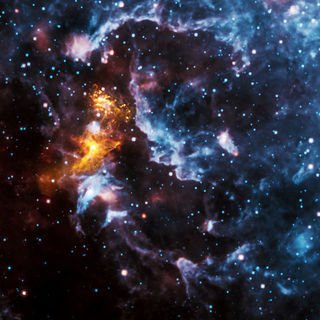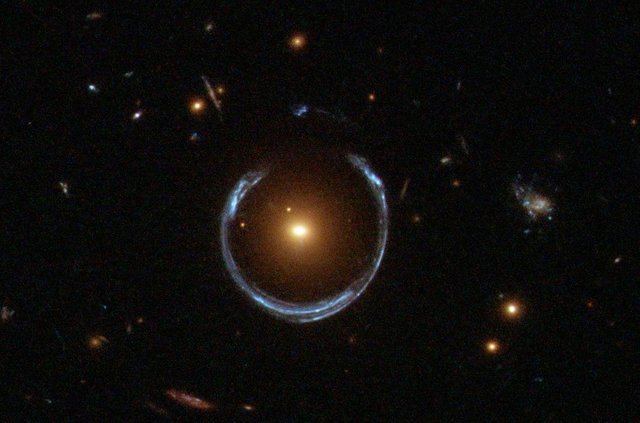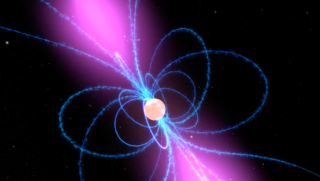Probing dark matter through its ability to collapse in a black hole within a neutron star
After a couple of weeks of (offline) vacation, I am now back online. And actually almost back to work too. As any scientist, the first thing I do is to catch up with the scientific literature I missed during my three weeks of absence (which I do during my last vacation days).

[image credits: Wikipedia]
In one of the articles I have been through caught my attention deeply, the authors use neutron stars to constrain various models of dark matter.
In particular, they use the fact that no black hole has destroyed the oldest neutron stars of the universe as a handle to dark matter.
Neutron stars, black holes and dark matter all in the same article! That’s a good topic to start writing again!
Let us first start with a small recap on dark matter, neutron stars and black holes before moving on with the main dish.
DARK MATTER
In the standard model of cosmology, a significant fraction of matter is of an unknown nature and is called dark matter.
The name comes from the fact it interacts gravitationally (like normal matter), and does not interact electromagnetically (and is thus dark).
As I explained it in details in this older post, dark matter had been initially proposed to explain the circular motion of stars in distant galaxies. There was a need for some missing mass to explain the observations.

[image credits: Wikipedia]
There are today many more indirect evidences for dark matter, that range from the cosmic microwave background, gravitational lensing (like on the picture on the right) or the formation of the large-scale structures in the universe.
Of course, we need to keep in mind that a universe without dark matter may work. This last option is indeed appealing as there is no direct observation of dark matter up to now.
On the other hand, it is healthy to keep an open mind and to test the dark matter hypothesis in all possible means. This is the topic of the day.
NEUTRON STARS
Neutron stars are the next-to-densest objects in the universe (after black holes). They originate from a massive star of about 1 to 3 times the mass of the sun that ran out of fuel.
Whereas the external layers of the stars explode (that is a supernova), its core gravitationally collapses. The protons and electrons that were present in the atomic structure of the initial star hence get close enough to each other, and are annihilated to give back neutrons.

[image credits: NASA]
Those neutrons are packed into a small sphere of radius of 10 to 20 kilometers, and quantum mechanics (and more precisely Pauli exclusion principle) makes the system stable.
To make a long story short, two different neutrons cannot occupy the same level of energy (that is Pauli exclusion principle). But we have many many neutrons in a neutron star so that higher and higher energy levels must be filled.
Avoiding any complicated detail, this yields a pressure that compensates the gravitational collapse and equilibrium is found.
Under certain conditions, neutron stars emit radiation that can be easily observed, as they generally spin very quickly and are connected to a very intense magnetic field (i.e., pulsars and magnetars).
BLACK HOLES

[image credits: Wikipedia]
Stars whose mass is between about 1 and 3 times the mass of our sun form a neutron star, as discussed in the previous section.
The same phenomenon occurs within heavier stars, but the neutron degeneracy pressure is not enough to compensate the gravitational collapse (that is stronger due to the more important starting mass).
The crush of the core of the star hence continues, and we end up with a very small region in space connected to an immense gravitational field.
CONSTRAINING DARK MATTER WITH NEUTRON STARS
It is now time to go back to the scientific article that I have read, and sketch the ideas behind that are at the end of the day pretty simple.
The key point is that dark matter particles can be captured by a neutron star and be trapped inside. If a large number of dark matter particles are trapped all together in the neutron star, they can form a mini black-hole inside the star (by collapsing gravitationally), which will eventually destroy it.
Since we have observed old neutron stars, this means that those stars have not been destroyed by those mini black holes. Dark matter models can be constrained as they must be such that they do no predict the destruction of all old neutron stars (which does not agree with data).
TAKE-HOME MESSAGE AND REFERENCES
In this article, the authors study for the first time how neutron stars can be used to constrain models featuring a dark matter particle. They rely on the fact that old neutron stars exist.
Dark matter can be trapped inside a neutron star and a given number of dark particles can hence be accreted inside the star during its lifetime.
Under certain conditions, those dark matter particles can form a mini black-hole that will eventually destroy the star. As old neutron stars are visible today are have thus not been destroyed, constraints on dark matter models can be derived.
Further information can be found below:
- For more information on neutron stars, please have a look to the NASA website.
- Another NASA page can be checked here, but this time on black holes.
- For dark matter, please have a look to this old Steemit post.
very educational and informative. Thanks for sharing this @lemouth
wow I didn't think of that. Every observation gets us closer to either understanding or disproving dark matter.
Yep, dark matter is currently one of the most puzzling stuff in particle physics and astrophysics and we are working hard to falsify the dark matter hypothesis. So far, it is however still very alive :)
Upvoted by Physics-Trail. Thanks!
You are welcome!
As my grandmother used to say
And what is exactly the thing you don't want? :)
I don't want dark matter models to destroy neutron stars or to work in a supermarket again
Ahah now I see :) A dark supermarket?!
Like Kurzgesagt would say, "We know more about what dark matter isn't that what it actually is". Great post btw :-)
Of course, otherwise this would not be a puzzle :)
Thanks a lot! :)
Very interesting post!
So if they would prove the theory of dark matter as wrong we would again have a problem to explain the circular motion of stars in distant galaxies... :D
Thanks for sharing! :)
Actually, there are alternatives, like modified gravity theories, that are not yet falsified too. The point is to study all possible options (and even finding new options) and try to see which one seems to be disfavored/favored by data.
Very good article. I am always thrilled to learn that a step was made towards proving or disproving the theory of dark matter, as @anarchyhasnogods said. Maybe I will be fortunate to learn in my life time, the truth about that theory and if I do, I believe the mystery of dark energy will be solved with it.
There are many way to seek for dark matter, that could be direct, indirect or at colliders. However, except a couple of puzzles in cosmic ray data (that could also be something else), we have not found anything, which constrain dark matter models a lot.
Outer space Is a Jesuit freemason deception.
nice post, the black hole picture reminded a video where the energy wave produced by colission of two black holes (newtons theory recently prooved). I don't know if i am wrong ..
followed and upvoted.
here is my recent writing, if possible please have a look. thanks :)
https://steemit.com/life/@applesspatrick/dyo-pakhu-jatra-a-newari-carnival-nepal
Newton theory is known for decades and has nothing to do with black hole merging (which is what you are talking about, I guess, otherwise please let me know). What has been recently observed is the merging of two black holes and the emission of gravitational waves, that were a prediction of general relativity so far not experimentally confirmed. Now it is :)